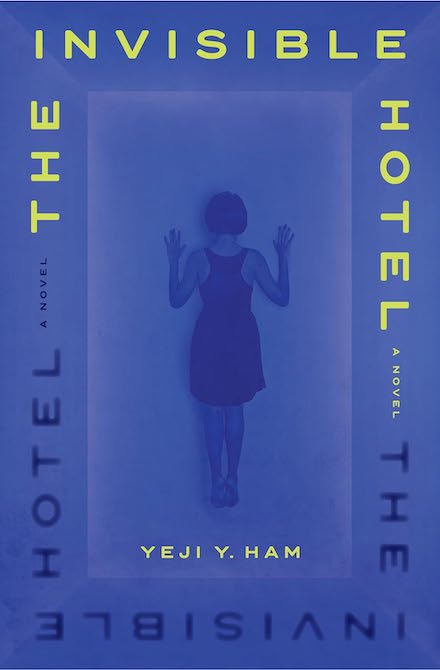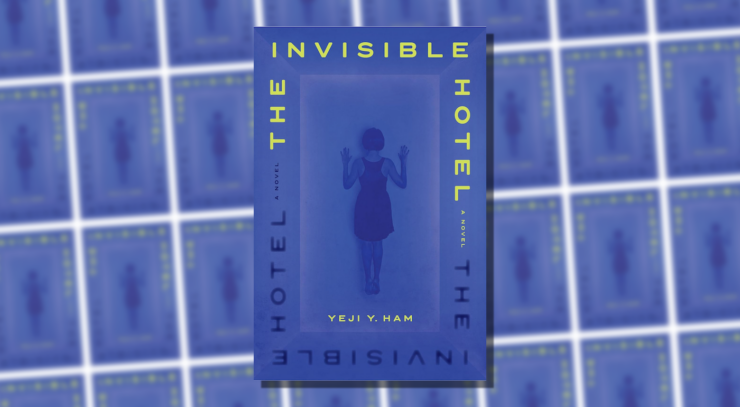Whether you’re staying at a roadside motel for the night or a four-star establishment, hotels can be a weird experience. Think about it: It’s a space intended to be both temporary and evocative of all the comforts of home; you don’t need to be a Coraline reader to know that “like something familiar, but different” can head into the uncanny very quickly.
It’s no surprise, then, that some writers have found hotels to be the best way to evoke the terror of the uncanny. Stephen King’s The Shining is arguably the best-known example of this, and for good reason. (To wit: It’s terrifying.) King’s not alone in tapping into the unsettling potential of hotels as a setting: Juan Martinez’s 2023 novel Extended Stay is set in a hotel located on the outskirts of Las Vegas that turns out to be a sentient being that doesn’t have its guests’ best interests at heart.
Yeji Y. Ham’s The Invisible Hotel is another entry in this unlikely subgenre, albeit one that blends its horror with surrealism and dream logic. It wouldn’t be out of place on a shelf or syllabus beside King’s and Martinez’s novels—but it also has something in common with Catherynne M. Valente’s Palimpsest, a novel about a mysterious city that only allows access to itself under specific circumstances. The hotel that haunts Yewon, the young woman at the heart of Ham’s novel, is something like that: a space at once liminal and shared, its agenda and reason for being mysterious.
There’s also the matter of the bones. We’ll get to the bones before too long, don’t you worry.
Buy the Book


The Invisible Hotel
At the beginning of The Invisible Hotel, Ham introduces us to Yewon, the novel’s protagonist and narrator. She’s a young South Korean woman who is, when the book opens, in the midst of the last shift at her retail job before the business closes down entirely. It’s there that a woman named Ms. Han approaches her, asking if Yewon would be willing to drive her to the prison where her brother is incarcerated. “I need to see him. I need to,” says Ms. Han.
After Ms. Han leaves, the manager at Yewon’s workplace mentions that Ms. Han has a North Korean accent; in the next few pages, we’ll learn that tensions are high between North and South Korea. Or there might be peace talks soon. Or both. That sense where anything might be possible — from nuclear warfare to landmark peace—isn’t necessarily grounds for hope, but it’s presented as even more unnerving than a more clarified option. Even so, this novel has been in a relatively realistic mode so far. Sure, there are allusions to hidden trauma and subjects the characters can’t broach, but still—the overarching sense is of a world that follows the same patterns as our own.
And then Yewon goes to her family’s home and notes that her mother is in the bathroom, washing something. “I used to help her,” Yewon thinks. “It was our family tradition.” At this point, readers might be wondering something like, Wait, what was your family tradition exactly?
Some were tiny, as small as my pinkie. A phalanx. Maybe a toe. In the basin, what would have been a scapula. A shoulder blade. Or something of a spine, a sternum. Shattered pelvis, scarred ribs, and snapped femur. Too shattered, too burnt, destroyed. Not a single bone was whole. As many as a hundred lay inside the bathtub.
Soon enough, we’ll learn a little more about the bathtub—including that it’s a family tradition to give birth to children there as well. The bones—and their smell, which Ham revisits repeatedly—also factor into The Invisible Hotel’s other deeply uncanny element: the hotel that gives the novel its title, and which Yewon repeatedly returns to in dreams.
There’s something symbolic about the bones: The idea of them as a kind of frustrating family tradition dovetails with Yewon’s frustrations at her small-town life and her inner conflict about whether she should seek out her own place in the world. But her familial ties prompt indecision, even as she’s aware that procrastinating on this can easily lead to spending months, if not years, in a kind of stasis.
A metaphorical stasis, that is. That’s before getting to the more literal stasis of the hotel from Yewon’s recurring dreams, which she gradually begins to understand has a historic weight to it. Yewon’s drives with Ms. Han also prove clarifying in some respects, even as the two women seem to be processing the same events in radically different ways.
The Invisible Hotel is a deceptively challenging read in how it moves in and out of different registers. At one moment, it’s a realistic coming-of-age tale; in the next, it veers into dreamlike Gothic horror. And yet that dissonance appears to be the point of the story being told: that living in close proximity (both literally and metaphorically) can create its own sort of horror and transform even the most quotidian moments into something best analyzed through dream logic.
“What should have been a temporary stay turned permanent. At the end of every wait, there was a door. We each had a room,” Yewon muses halfway through the novel. “All of us, waiting. What would come after?” Ham sustains the tension of that final question across the breadth of this novel. It isn’t always an easy read, but I suspect I’ll be thinking about it for a long time to come.
The Invisible Hotel is published by Zando.










